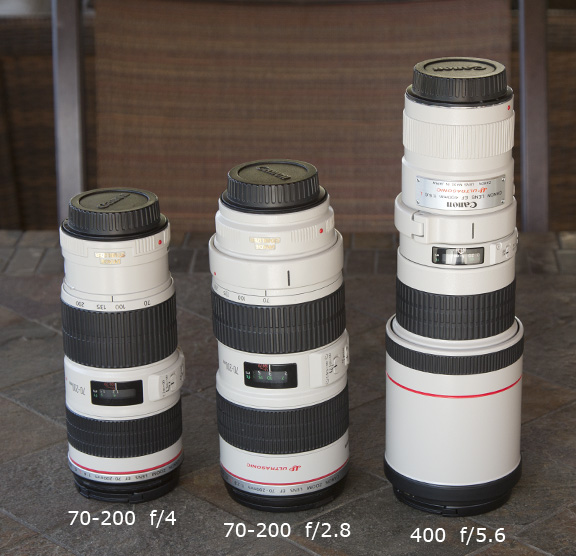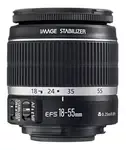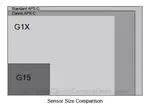The Canon 70-200 f4 Lenses
What are they good for?
WRITTEN BY: BRUCE LOVELACE
UPDATED: DECEMBER 28, 2023
 As soon as I had the 70-200mm lens in my hand
As soon as I had the 70-200mm lens in my handI fell in love with its size and build quality.
With the Canon 70-200 f4 lens you get 95% of the capabilities of the 70-200 f2.8 lens at about 60% of the price (the IS-image stabilization versions).
The 70-200mm f/4 is great for you if want to try out a medium telephoto zoom lens, want great performance, but don't want to carry around a heavy beast that cost you a boatload of cash.
A little bit of muscle fatigue from shooting with a heavier lens like the Canon 70-200 f2.8 for a few hours might be enough motivation to go with this smaller, but sharp and capable Canon camera lens.
What's the 70-200 f/4 lens good for
The 70-200 f/4 is most known to be a good focal length for shooting portraits, but it's a lot more versatile than that. I used my 70-200 (f 2.8) extensively for shooting portraits because it's great for small family poses as well as head shots. Here are the most common ways to use this lens.
PORTRAITS. As mentioned, the 70-200 f/4 is the perfect lens for doing portrait photography. You get great bokeh with the lens, particularly at 200mm and wide open at f/4.0. You can pose your smaller families and head shot photos from a comfortable working distance and get a nice pleasing perspective of your subjects.
At 70mm, the 70-200mm f/4 is good for full length poses of individuals as well as group portraits indoors with a moderate amount of space.
SPORTS. The 70-200mm f/4.0 lens is a good lens for sports photography. It's great for your kids soccer, Little League baseball game, or wrestling matches where you're not too far from the action. With a relatively fast maximum aperture of f/4.0 you can get high shutter speeds to freeze the action.
You can also use the 70-200mm combined with an extender to get extra close to photograph the action.
LANDSCAPES. Newbie photographers often limit their landscape photography gear to wide angle lenses. That's a big mistake. This lens can be used for detail shots and more "flat" compressed perspectives and textures of the natural environment.
You can get close up nature photos with the focal length set to 70mm.
WILDLIFE. At 200mm focal length you have enough power to get some good wildlife photos at the zoo, a walk in the woods, or a few casual snapshots of your own little rug rats in motion.
The 70-200mm lens comes up short as a lens for wildlife photography out "in the wild" because of the distances you typically encounter between you and the wildlife. You can photograph birds at your own bird feeder, but you need more magnification for shooting birds in their natural environment.
how big is the Canon 70-200 f/4.0 Lens
The photo below gives you a side by side comparison of the 70-200mm lens with its larger brother and sister. It's relatively shorter length and smaller diameter make it easier to carry with you when you travel.
The 70-200 f/4 is a little shorter and much lighter than it's big brother the 70-200 f/2.8, and is dwarfed by my 400mm f/5.6 lens. The Canon EF 70-200mm weighs just 1.7 lbs. and is just under 7 inches tall.
Best Feature of the 70-200mm f/4 Lens
Size. Yes, you get a really sharp "L" lens, and yes it's great for portraits, and it's certainly versatile enough for a lot of other shooting situations. For me though, it's all those performance qualities packed into a zoom telephoto lens that is so light and easy to work with.
The photo below shows me sliding the f/4 into my favorite belt bag. I love the convenience of having my cameras and accessories available to use in a split second.
If you like to travel lightly and don't need to be a fashion statement, consider using a belt-pack. I can easily have my 70D body with lens attached or the f/4 lens available to me at waist level.
 Canon 70-22mm f/4 fits easily in my small waist-level, beltpack, "belly bag"
Canon 70-22mm f/4 fits easily in my small waist-level, beltpack, "belly bag"The CANON L-SERIES lenses are highly sought after but are accompanied by a hefty price tag. Many believe that the Canon 70-200 lens without IS (image stabilizer) is simply the best value in the the L-series.
There are actually three versions of the Canon 70-200 f4 lens as well as three versions of the Canon 70-200 f2.8.
versions of the canon 70-200mm lens
There are 6 different versions of the Canon 70-200mm lens. There are three f/4.0 versions and three f/3.8 versions. The newer versions have superior performance than the lenses they replaced.
- Canon EF 70-200mm f/4.0 L USM Lens released in 1999
- Canon EF 70-200mm f/4.0 L IS USM Lens released in 2006
- Canon EF 70-200mm f/4L IS II USM Lens released in 2018
- Canon EF 70-200mm f/2.8 L IS USM Lens released in 2001
- Canon EF 70-200mm f/2.8 L IS II USM Lens released in 2010
- Canon EF 70-200mm f/2.8 L IS III USM Lens released in 2018
The f4 weighs about half of what the Canon 70-200 f 2.8 does. Not only is that surprising but it's also significant as well. It's got the same zoom range and magnification power for less than half the cost.
Maybe that's why it is such a popular Canon lens choice. There are a few things you may want to be aware of when considering using or buying this lens.
- It outsells the Canon f 2.8 by about two to one on Amazon.
- You can still get a eye-pleasing shallow depth of field at f-4 which is great for portrait photography.
- The original Canon 70-200 f4 version does not have a great weather seal like the more modern versions.
You will still look and perform impressively as a photographer when you carry this simpler, smaller Canon lens versus carrying the Canon 70-200 f 2.8.
One of the best Canon accessories for this lens is a tripod collar mount. It gives you much better balance on a tripod or monopod and super easy camera rotation.
This lens has a constant aperture through its entire zoom range. That means that should not much shift in focus if you go to different zoom factors once you have focused on your subject.
One of the few drawbacks with this lens is in low light situations. There may be times when you wish you had that extra f-stop of light collecting glass like the Canon 70-200 f2.8.
Fortunately, modern Canon DSLRs have dramatically improved quality with higher ISO settings, meaning you can get great results with less available light. You also have the 4-stop slower shutter speed capabilities with the f/4.0 L IS USM Lens.
Specific features of the Canon 70-200 F4 L IS USM Lens:
- Minimum focus distance is 1.2 meters.
- Image stabilizer has 2 different modes and is rated at 4 stops.
- 1 Fluorite lens element and 2 UD lens elements for improved optical performance.
- Good background blur because of circular diaphragm.
When you spend a lot on a good lens you will also want to consider what Canon 70-200 lens accessories are worth buying too.
As an Amazon affiliate Canon Camera Geek receives a small commission from qualifying purchases, at NO added cost to you.
I spend a lot of time on the major camera review sites, manufacturer's sites, as well as read many post in the photography equipment forums. Here are some of the phrases by people describing the Canon 70-200mm lens:
- "ergonomics and operation are flawless, "
- "the IS is so good , I can leave my tripod at home,
- "quick and quiet autofocusing,"
- "Super sharp images," "light weight"
- "This by far has to be the best lens I have ever used"
- "it's light, compact, and it keeps its size even zooming,"
- "The pictures are fantastic and the sharpness is nothing short of amazing."
There is no doubt that every camera and lens manufacturer produce a few lemons, just like the automobile manufacturers do.
When you get 91% of reviewers giving a product a 5-star rating, it's a pretty safe bet that it is a great product. You can only read so many reviews and opinions on anything and then you just have to go out and give it a try yourself.
closing thoughts on the Canon 70-200mm f/4.0
All of the versions of the 70-200mm f/4.0 lens are great lenses. The newest version is the best yet, but you can save money if you go with the 2nd version of this lens.
I hope you found this article on the Canon EF 70-200mm f/4.0 lenses helpful. Use the search box below to search this site for any topic or use the related article links below my signature.
Search for articles on this Site:


Bruce Lovelace is the publisher of Canon Camera Geek. Read more about him on the About Page. He also publishes how to articles and camera gear reviews at the Photography Tips website.
View some of Bruce's photos on Instagram and Flickr. Join the tribe of followers on YouTube. Bruce also runs photo workshops and provides 1 on 1 digital photography coaching.
Back Return to: ALL Canon Camera Lenses
Recent Articles
-
Choose the Right Memory Card for Your Canon R6 Mark II: Speed And Size
Nov 05, 25 02:04 PM
R6 Mark II Memory Card -
Canon G1x Mark II vs G1X-Side By Side Comparison of Canon G1X Cameras
Oct 22, 25 08:35 AM
G1 X Mark II vs. G1 X: Is the New Version a HUGE Leap... Or a Massive Mistake? Canon responded to the criticisms of the original G1X. Canon G1X Mark II vs G1X -
Sony RX100 III vs G1x Mark II by Canon. Side by Side Comparison
Oct 22, 25 08:07 AM
It's another one of those epic camera battles, this time not the Canon vs Nikon but rather the RX100 III Vs G1X Mark II battle. -
Canon R6 Mark II FAQ. Answers To All of Your Canon R6 M2 Questions
Sep 01, 25 07:51 AM
There's a lot you can easily learn about Canon's mirrorless R6 Mark II camera. Get your questions answered in this R6 Mark II FAQ -
Canon G1X Sensor Size. What Are The Specs on The Canon G1X Sensor
Aug 26, 25 11:39 AM
Here is a comparison of the Canon G1X sensor size with the rest of the "G" series Canon cameras
Read the everyday consumer reviews for yourself:
As an Amazon affiliate Canon Camera Geek receives a small commission from qualifying purchases, at NO added cost to you.
Buyer Reviews of Canon 70-200mm f/4.0 Lens on AmazonMust-have 70-200 lens accessories:
 Lens Hood for 70-200mm f/4
Lens Hood for 70-200mm f/4 Canon 70-200 f/4 Lens Collar
Canon 70-200 f/4 Lens Collar

















